|
||||||||||||||||||||||||||||||||||||||||||||||||
|
|
|||
|
Top 10 Philippine Imports from All Countries: February 2005 |
|||
|
Gainers |
Losers |
||
|
Mineral Fuels, Lubricants and Related Materials |
65.2 |
Plastics in Primary and Non-Primary Forms |
-28.5 |
|
Cereals and Cereal Preparations |
53.9 |
Electronic Products |
-15.4 |
|
Organic and Inorganic Chemical |
4.6 |
Iron and Steel |
-12.2 |
|
|
|
Telecommunication Equipment and Electrical Machinery |
-10.7 |
|
|
|
Textile Yarn, Fabrics, Made-up Articles and Related Products |
-7.0 |
|
|
|
Industrial Machinery and Equipment |
-3.6 |
|
|
|
Transport Equipment |
-2.3 |
January to February total trade stands at $12.226 billion
Total external trade in goods for January to February 2005 amounted to $12.226 billion representing a growth of 1.7 percent from $12.016 billion during the same period a year earlier. However, total foreign-made merchandise was down by 3.4 percent to $5.962 billion from $6.173 billion. Exports on the other hand registered a year-on-year increment of 7.2 percent to aggregate dollar revenue of $6.264 billion from $5.843 billion last year. Balance of trade in goods (BOT-G) surplus for the Philippines reached $302 million from last year’s deficit of $330 billion.
Figure 1A. Philippine Trade Performance in January - February :2004 and 2005
(F.O.B. Value in Million US Dollar)
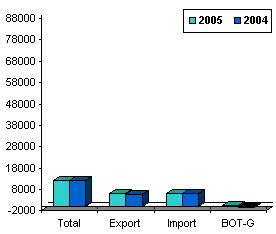
Figure 1B. Philippine Trade Performance in February :2004 - 2005
(F.O.B. Value in Million US Dollar)
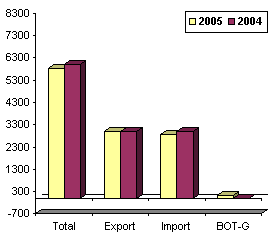
February imports register 4.8 percent decrease
Total merchandise trade for February 2005 declined by 2.7 percent to $5.832 billion from $5.993 billion during the same period a year ago. Dollar-inflow generated by exports amounted to $2.982 billion, or 0.6 percent lower than last year’s $2.999 billion. Likewise, expenditures for imported goods declined by 4.8 percent to $2.850 billion from $2.994 billion. The balance of trade in goods (BOT-G) registered a surplus at $132 million, higher compared to last year’s surplus of $5 million.
Electronic products account for 44.4 percent of import bill
Accounting for 44.4 percent of the total aggregate import bill, payments for electronic products amounted to $1.265 billion or a 15.4 percent drop over last year’s figure of $1.495 billion. Compared to the previous month’s level, purchases fell by 4.5 percent from $1.325 billion.
Imports of mineral fuels, lubricants and related materials in February ranked second with 14.9 percent share. Expenditures at $423.68 million, posted a 65.2 percent growth over the previous year’s level of $256.43 million.
Industrial machinery and equipment, the third top import was worth $120.78 million, or a reduction of 3.6 percent from $125.24 million a year earlier.
Iron and steel, contributing 3.3 percent to the total bill, was RP’s fourth top import for the month with payments placed at $92.55 million or a decline of 12.2 percent from last year’s $105.42 million.
Transport equipment, accounting for 2.9 percent of the total imports, ranked fifth as foreign bill amounted to $81.66 million, an decrease of 2.3 percent from $83.54 million last year.
Expenditures for telecommunication equipment and electrical machinery, with a 2.3 percent share, went down by 10.7 percent to $65.77 million from $73.67 million in February 2004.
Rounding up the list of the top imports for February 2005 were cereals and cereal preparations, $64.62 million; plastics in primary and non-primary forms, $55.47 million; organic and inorganic chemical, $53.03 million; and textile yarn, fabrics, made-up articles and related products, $51.15 million.
Aggregate payment for the country’s top ten imports for February 2005 reached to $2.273 billion or 79.8 percent of the total bill.
Figure 2. Philippine Top Imports in February 2004 and 2005
(F.O.B. Value in Million US Dollar)
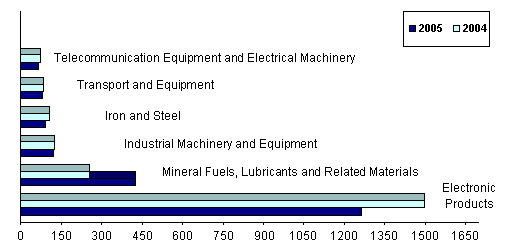
Capital goods account for 38.6 percent of the total imports
Capital goods comprising 38.6 percent of the total imports declined by 11.2 percent year-on-year to $1.099 billion from $1.238 billion. The bigest share went to telecommunication equipment and electrical machinery with a 22.1 percent share of the total imports and billed at $629.56 million.
Payments in February for raw materials and intermediate goods accounted for 35.2 percent as importation was reduced by 13.9 percent to $1.004 billion from last year’s figure of $1.166 billion. Semi-processed raw materials got the major share of 32.7 percent and valued at $931.79 million.
Expenditures for mineral fuels, lubricants and related materials accelerated by 65.2 percent to $423.68 million from $256.43 million during the same period of 2004.
Purchases of consumer goods, amounted to $261.58 million, a rise of 22.5 percent from $213.55 million in February 2004, while special transactions decreased by 48.9 percent to $61.21 million from $119.71 million.
Figure 3. Philippine Imports by Major Type of Goods in February: 2004 and 2005
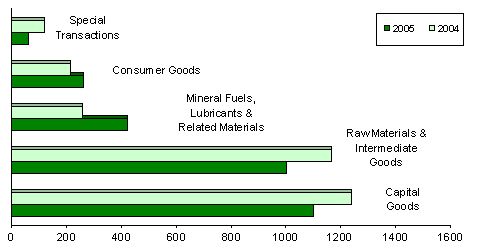
Japan corners 18.3 percent of february import bill
Imports from Japan accounting for 18.3 percent of the total import bill, went down by 15.2 percent to $520.60 million from $614.17 million during the same period of 2004. Exports to Japan, amounted to $612.99 million yielding a two-way trade value of $1.134 billion and a trade surplus for RP placed at $92.38 million.
United States, the country’s second biggest source of imports for February with a 15.9 percent share, reported shipments billed at $453.68 million against exports earnings of $512.68 million. Total trade amounted to $966.36 million, with a trade surplus registered at $59.01 million.
Singapore followed as the third biggest source of imports. With payments worth $222.28 million, imports was down by 10.0 percent from $246.96 million, while revenue from RP’s exports reached $170.89 million resulting to a total trade value of $393.17 million and a $51.40 million deficit for Philippines.
Other major sources of imports for the month of February were Taiwan, $206.38 million; Republic of Korea, $168.85 million; People's Republic of China, $150.71 million; Malaysia, $117.73 million; Hong Kong, $111.30 million; Thailand, $102.33 million; and Iran, $94.73 million.
Payments for imports from the top ten sources for the month amounted to $2.149 billion or 75.4 percent of the total.
Figure 4. Philippine Imports by Country in February: 2005
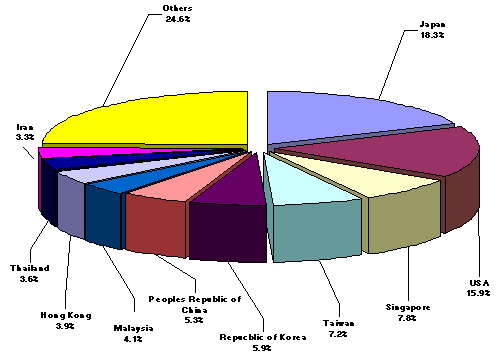
As of press time, 21 out of 51,473 export documents and 40 out of 60,982 import documents are still expected from the ports.
|
(Sgd.) CARMELITA N. ERICTA |
Source: National Statistics Office
Manila, Philippines
